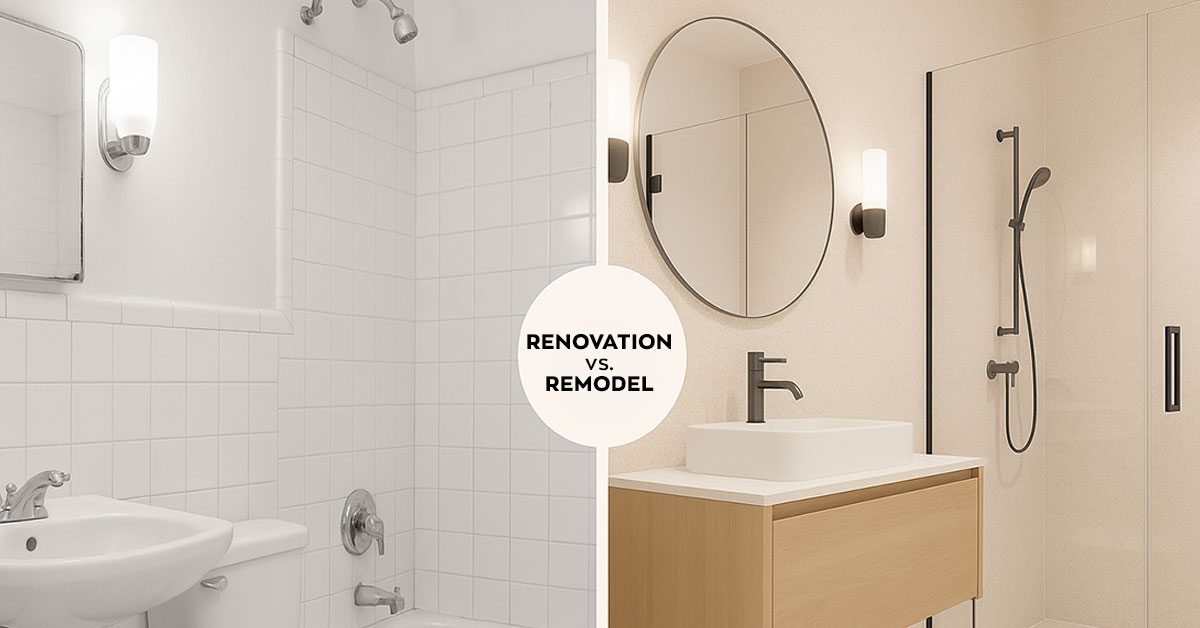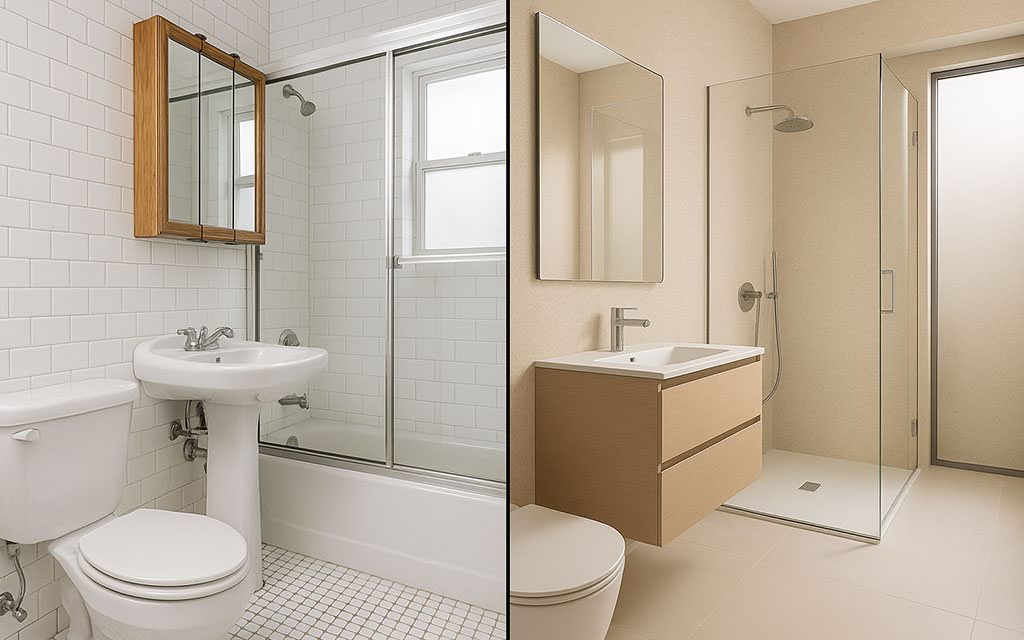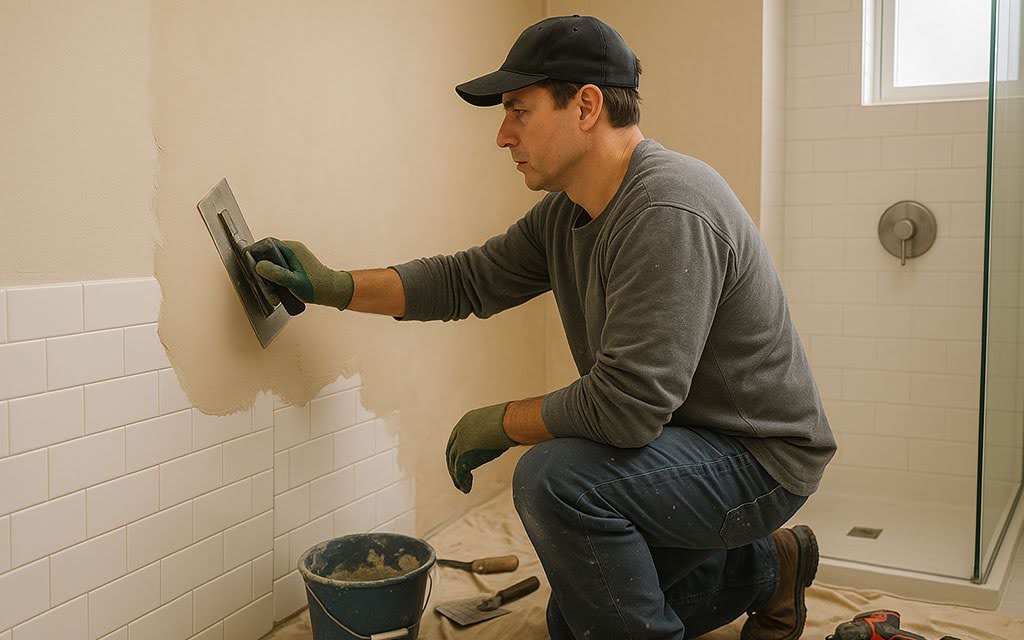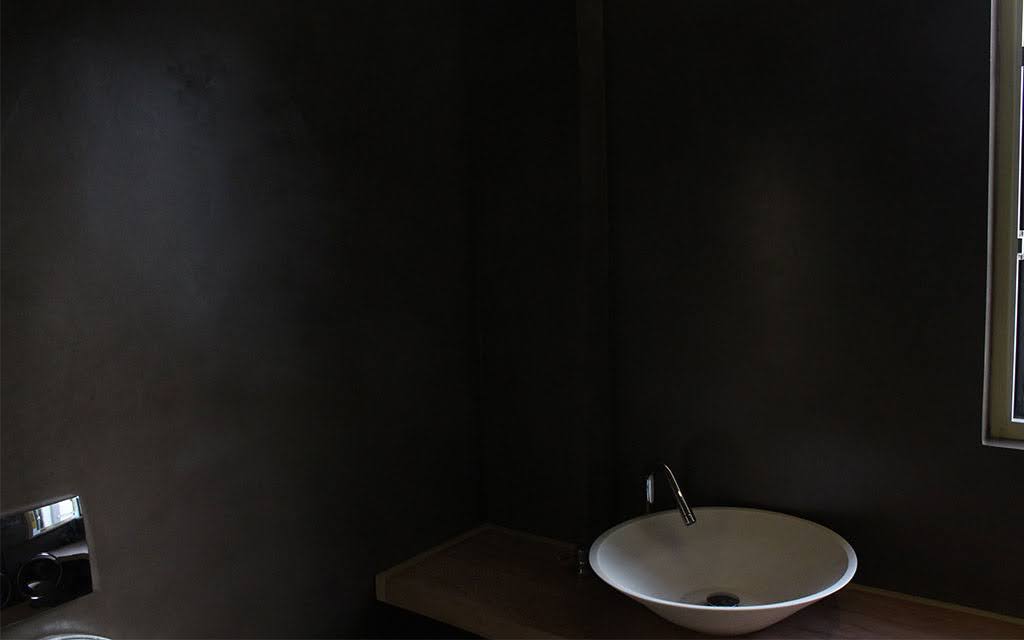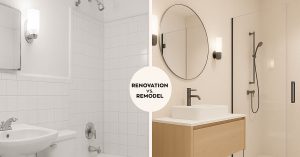Have you ever found yourself wondering whether there’s a meaningful distinction between a bathroom remodel and renovation? While these terms are frequently used interchangeably in casual conversation, understanding their unique characteristics can fundamentally transform how you approach planning and budgeting for your upcoming project. Whether you’re dreaming of a simple refresh to breathe new life into your existing space or envisioning a complete transformation that reimagines your bathroom’s functionality, grasping the nuanced differences between these approaches becomes essential for making informed decisions that align with your goals and budget.
Key Takeaways
- The terms “remodel” and “renovation” have distinct meanings and implications.
- A bathroom remodel typically involves altering the layout and design of the space.
- Bathroom renovations often focus on restoring and updating existing features without major structural changes.
- Understanding these differences can impact the overall cost and time required for your project.
- Choose the right approach based on your long-term home improvement goals.
Table of Contents
Understanding the Definitions of Renovation and Remodeling
Distinguishing between renovation and remodeling serves as the foundation for making informed decisions about your home improvement project, as each term encompasses distinctly different approaches to transforming your living space. Understanding these fundamental differences empowers homeowners to communicate effectively with contractors, set realistic expectations, and choose the most appropriate path forward based on their specific needs and circumstances.
What is Renovation?
Renovation encompasses the process of improving and updating an existing space while preserving its fundamental structure and layout, focusing on enhancing both aesthetic appeal and functional performance without undertaking major architectural changes. This approach typically includes activities such as applying fresh paint to walls and ceilings, replacing outdated fixtures with modern alternatives, installing new flooring materials, updating lighting systems, and refreshing hardware throughout the space.
When applied to bathroom spaces, renovation projects might involve installing a new vanity with improved storage capacity, upgrading to energy-efficient lighting fixtures that provide better illumination, introducing contemporary color schemes through paint and accessories, or replacing worn flooring with durable, water-resistant materials. These improvements collectively transform the space’s appearance and functionality while working within the existing footprint and infrastructure.
What is a Remodel?
Remodeling, in contrast, involves comprehensive changes that fundamentally alter a space’s structure, layout, or configuration to create an entirely different environment that better serves the homeowner’s evolving needs and preferences. This approach often requires modifying load-bearing walls, relocating plumbing and electrical systems, expanding the space’s footprint, or completely reconfiguring the layout to optimize flow and functionality.
A prime example of bathroom remodeling would be converting a compact half-bathroom into a full bathroom by adding shower facilities, which necessitates significant plumbing modifications, potential electrical upgrades, and possibly structural changes to accommodate the new fixtures. Other remodeling projects might include removing walls to create an open, spa-like environment, installing luxury features such as heated floors or steam showers, or completely reconfiguring the space to improve accessibility for aging in place.
Bathroom Remodel vs Renovation: What’s the Difference?
The fundamental distinction between a bathroom remodel vs renovation lies in the comprehensive scope of work involved and the extent to which each approach transforms your existing space. While both options aim to improve your bathroom’s appearance and functionality, they achieve these goals through markedly different strategies that carry distinct implications for cost, timeline, and the level of disruption you’ll experience during the project.
Scope of Work
Renovation projects concentrate on enhancing and updating existing elements within your bathroom while maintaining the current layout and infrastructure, making them ideal solutions for spaces that function well but simply need aesthetic refreshing or minor functional improvements. These projects typically involve replacing fixtures such as faucets, lighting, and hardware, applying new paint or wallpaper, updating mirrors and accessories, and potentially refinishing existing surfaces to restore their original beauty.
Remodeling projects, however, embrace a more comprehensive transformation approach that fundamentally changes how the space looks, functions, and feels through extensive modifications to layout, infrastructure, and design elements. These ambitious undertakings might include relocating major fixtures like toilets or bathtubs, installing custom cabinets and built-in storage solutions, expanding the space by removing or adding walls, upgrading plumbing and electrical systems to accommodate new features, and incorporating luxury amenities that weren’t previously possible within the existing configuration.
Structural Changes
When your vision includes significant structural changes to your bathroom’s layout or configuration, remodeling becomes the necessary approach to achieve your goals safely and effectively. These modifications typically require professional architectural consultation to ensure structural integrity, obtaining proper permits from local building authorities, and adhering to current building codes and safety regulations throughout the construction process.
Major structural modifications might involve relocating a toilet to improve traffic flow, expanding a shower area by removing adjacent closet space, installing a soaking tub that requires floor reinforcement, or creating barrier-free accessibility features that necessitate threshold modifications and grab bar installations. Understanding whether your project requires structural changes helps determine not only the appropriate approach but also the level of professional expertise, permits, and budget allocation necessary for successful completion.
Aspect | Renovation | Remodel |
Definition | Enhancement of existing features without structural changes | Complete transformation involving layout and structural modifications |
Scope of Work | Surface-level updates, fixture replacement, cosmetic improvements | Major changes including plumbing relocation, wall modifications, layout alterations |
Permits Required | Rarely needed for cosmetic changes | Often required for structural, plumbing, and electrical work |
Timeline | 1-3 weeks for most projects | 4-8 weeks or longer depending on complexity |
Budget Range | $3,000 – $15,000 typically | $15,000 – $50,000+ depending on scope |
Disruption Level | Minimal, bathroom often remains partially functional | Significant, usually requires alternative bathroom arrangements |
Common Types of Bathroom Projects
Homeowners embarking on bathroom improvements discover a wide spectrum of possibilities ranging from simple, budget-friendly updates that can be completed over a weekend to comprehensive transformations that completely reimagine the space’s potential. Understanding the various project types available helps you identify which approach aligns best with your vision, timeline, and budget while ensuring that your investment delivers the desired improvements to your daily routine and home value.
Renovation Ideas for Your Bathroom
Simple yet impactful renovation strategies can dramatically refresh your bathroom’s appearance and functionality without requiring extensive construction or major budget allocation, making them perfect solutions for homeowners seeking meaningful improvements with minimal disruption. Consider updating outdated light fixtures with contemporary designs that provide better illumination and energy efficiency, which can instantly modernize the space while improving functionality for daily grooming tasks.
Re-grouting tile surfaces removes years of accumulated stains and discoloration while creating crisp, clean lines that make existing tiles appear brand new, often eliminating the need for complete tile replacement. Repainting bathroom cabinets or vanities in trending colors transforms these prominent features into striking focal points, while new hardware such as drawer pulls and cabinet knobs adds sophisticated finishing touches that tie the entire aesthetic together seamlessly.
Popular Bathroom Remodeling Projects
Comprehensive remodeling projects offer opportunities to address fundamental functionality issues while incorporating luxury features and modern conveniences that weren’t possible within the original layout constraints. Installing new walk-in showers with multiple shower heads, built-in seating, and glass enclosures creates spa-like experiences while improving accessibility for users of all ages and abilities.
Converting underutilized spaces into full bathroom facilities adds significant value to your home while providing much-needed convenience for growing families or frequent guests. Altering the layout to create more efficient traffic patterns, maximize storage capacity, or accommodate universal design principles ensures that your investment serves your family’s evolving needs for decades to come.
Cost Considerations Between Renovation and Remodeling
Understanding the financial implications of bathroom remodel vs renovation becomes crucial for making informed decisions that balance your desired improvements with realistic budget constraints and long-term financial goals. Renovation projects typically offer more predictable costs since they work within existing infrastructure and avoid the complications that can arise from opening walls or moving major systems, making them attractive options for homeowners seeking maximum impact from limited budgets.
Remodeling costs, however, can vary dramatically based on the extent of structural changes, quality of materials selected, and unforeseen complications that emerge once demolition begins, such as outdated plumbing that requires updating to meet current codes or structural issues that need addressing before proceeding with planned improvements.
Budgeting for a Bathroom Renovation
Successful renovation budgeting begins with realistic assessment of material costs, labor expenses, and potential contingencies that might arise during the project, even when structural changes aren’t planned. Cosmetic changes such as painting, new fixtures, and updated accessories typically represent the most cost-effective approaches to transformation, often delivering impressive results for investments ranging from several hundred to a few thousand dollars.
Creating detailed budgets that account for every component, from primer and paint to new faucets and lighting fixtures, helps prevent cost overruns while ensuring that you can complete the entire project without running short of funds for finishing touches that tie everything together professionally.
Understanding the Expenses of a Bathroom Remodel
Remodeling expenses encompass not only materials and labor but also permits, inspections, potential structural modifications, and the cascading costs that can result from relocating plumbing or electrical systems throughout your home. Professional installation becomes essential for major modifications, and skilled tradespeople command premium rates that reflect their expertise and the complexity of integrating new systems with existing infrastructure.
Planning for unexpected discoveries such as water damage behind walls, outdated electrical systems that require upgrading, or structural modifications needed to support new fixtures helps prevent budget shock and project delays that can derail your timeline and significantly increase overall costs.
Cost Category | Renovation Range | Remodel Range |
Labor | $2,000 – $6,000 | $8,000 – $20,000+ |
Materials | $1,000 – $8,000 | $5,000 – $25,000+ |
Permits & Inspections | $0 – $200 | $300 – $1,500+ |
Fixtures | $500 – $3,000 | $2,000 – $15,000+ |
Unexpected Issues | $200 – $1,000 | $2,000 – $8,000+ |
Total Project Cost | $3,000 – $15,000 | $15,000 – $50,000+ |
Permits and Regulations: Renovation vs. Remodeling
Navigating the complex landscape of permits and building regulations represents one of the most critical aspects of bathroom projects, as compliance with local codes ensures safety while protecting your investment from future complications during home sales or insurance claims. Cosmetic changes such as painting, replacing fixtures, and updating accessories rarely require permits since they don’t affect structural integrity or safety systems within your home.
However, projects involving structural changes, plumbing modifications, or electrical upgrades typically mandate permits and inspections to ensure compliance with current building codes and safety standards that protect both residents and future occupants.
When Permits are Required
Understanding when permits become necessary helps homeowners plan appropriately and avoid costly delays or legal complications that can arise from unpermitted work, which may require expensive corrections or complete reconstruction to meet code requirements. Relocating plumbing fixtures such as toilets, sinks, or showers almost always requires permits since these modifications affect your home’s waste and water supply systems.
Electrical work including new circuits, upgraded panels, or additional outlets requires permits and professional installation to ensure safety and code compliance, while structural modifications such as removing walls or creating new openings mandate engineering evaluation and permit approval to maintain your home’s structural integrity.
Local Building Codes and Inspections
Local building codes vary significantly between municipalities and evolve regularly to incorporate new safety standards and construction techniques, making it essential to research current requirements before beginning any project that might require permits or inspections. These regulations typically address ventilation requirements, electrical safety standards, plumbing code compliance, and accessibility requirements that ensure your improvements meet current standards.
Scheduling required inspections at appropriate project milestones prevents delays and ensures that work progresses according to approved plans, while failing to obtain necessary permits can result in fines, forced corrections, or complications when selling your home that far exceed the original permit costs.
Choosing Between Renovation and Remodeling for Your Bathroom
The decision between renovation or a bathroom remodel requires careful evaluation of multiple factors including your current bathroom’s condition, available budget, desired improvements, and long-term plans for your home ownership. Small bathroom spaces might benefit more from clever renovation strategies that maximize existing square footage through improved storage and updated fixtures, while larger spaces might accommodate comprehensive remodeling that adds luxury features and improved functionality.
Factors to Consider
Your current bathroom’s structural condition plays a crucial role in determining the most appropriate approach, as spaces with outdated plumbing, electrical systems, or structural issues might require remodeling regardless of your initial preferences. Budget considerations extend beyond initial project costs to include the value that different improvements add to your home, with comprehensive remodels typically providing greater return on investment in higher-end properties.
Timeline requirements also influence the decision, as renovations can often be completed with minimal disruption to daily routines while remodels typically require alternative bathing arrangements for several weeks during construction phases.
Long-Term Home Improvement Goals
Aligning your bathroom project with broader home improvement objectives ensures that your investment contributes to your overall vision for your property while avoiding piecemeal improvements that might conflict with future plans. Homeowners planning to remain in their homes for many years might prioritize comprehensive remodeling that addresses all current and anticipated future needs, while those considering relocation within a few years might focus on renovation improvements that enhance marketability without over-investing in personal preferences.
Consider how your bathroom improvements integrate with other planned home updates, ensuring that design choices, quality levels, and functionality improvements create cohesive value throughout your property rather than isolated upgrades that don’t contribute to your home’s overall appeal and market position.
Why Terrazzo GraniTech is a Game Changer for Bathroom Renovation
In the evolving landscape of bathroom renovation solutions, Terrazzo GraniTech emerges as a revolutionary material that addresses many traditional challenges homeowners face when updating their bathrooms, particularly when dealing with existing tile surfaces that would typically require costly and disruptive demolition. This innovative acrylic resin-based plaster represents a paradigm shift in renovation methodology, offering the ability to transform outdated spaces without the extensive demolition, permitting delays, and waste disposal issues that characterize conventional renovation approaches.
The patented Terrazzo GraniTech system delivers exceptional durability through its anti-crack memory resin technology, making it significantly more robust than traditional cement-based plasters that are prone to hairline cracks and chipping over time. This advanced formulation proves particularly valuable in wet areas where moisture resistance and longevity become critical factors for maintaining both aesthetic appeal and structural integrity throughout years of daily use.
Professional contractors and designers consistently praise Terrazzo GraniTech for its versatility in addressing challenging renovation scenarios that would typically require extensive structural modifications or complete demolition. The material’s ability to be applied directly over existing tiles, vanities, and various surfaces eliminates the need for tear-out work that often reveals unexpected complications such as water damage, outdated plumbing, or structural issues that can dramatically increase project costs and timelines.
From a cost-effectiveness perspective, Terrazzo GraniTech delivers substantial savings by eliminating demolition expenses, waste disposal fees, and the potential for discovering hidden problems that require additional repairs. Homeowners report cost savings of up to 60% compared to traditional bathroom and shower renovation methods, while simultaneously achieving a sophisticated, seamless finish that rivals high-end custom installations at a fraction of the typical investment.
The material’s seamless, jointless finish creates an inherently hygienic surface that eliminates grout lines where bacteria and mold typically accumulate, making it an ideal choice for health-conscious homeowners seeking low-maintenance solutions. This characteristic proves particularly valuable in bathroom environments where cleanliness and moisture resistance are paramount concerns that affect both daily usability and long-term maintenance requirements.
Installation efficiency represents another significant advantage, as experienced applicators can typically complete bathroom transformations in days rather than weeks, minimizing disruption to household routines while delivering professional results. The streamlined application process eliminates many of the coordination challenges associated with traditional renovations, where multiple trades must sequence their work carefully to avoid conflicts and delays.
Design flexibility remains unlimited with Terrazzo GraniTech, as the material accommodates various textures, colors, and finishes that can complement any aesthetic vision from minimalist modern to richly textured traditional styles. This adaptability ensures that homeowners don’t need to compromise their design preferences to benefit from the material’s practical advantages, creating opportunities for truly personalized spaces that reflect individual tastes and lifestyle requirements.
The environmental benefits of choosing Terrazzo GraniTech extend beyond waste reduction through eliminated demolition, as the durable finish reduces the frequency of future renovations while the installation process generates minimal construction debris compared to traditional tile removal and disposal methods, making it a more sustainable choice than tadelakt or microcement bathroom installations that often require complete substrate preparation.
Waterproof Plaster Comparison | Terrazzo GraniTech | Tadelakt | Microcement |
Material Base | Acrylic resin-based | Lime-based (Morocco clay) | Cement-based with polymers |
Waterproof Rating | Superior water-resistance | Naturally waterproof (best) | Waterproof with sealer |
Application Complexity | Moderate – professional recommended | High – requires master craftsman | Moderate – skilled application |
Installation Time | 3-7 days typical | 2-3 weeks (7-8 coats) | 1-2 weeks |
Over Existing Surfaces | Yes – tiles, walls, floors | Requires substrate preparation | Yes – with proper preparation |
Crack Resistance | Superior anti-crack technology | Prone to hairline cracks | Good with proper application |
Maintenance Level | Very low – simple cleaning | Moderate – periodic soap reapplication | Low – occasional sealing |
Repair Capability | Spot repairs possible | Complete reapplication needed | Patch repairs possible |
Color/Texture Options | Unlimited custom options | Limited natural tones | Wide variety available |
Cost Range (per sq ft) | $8-15 (60% savings vs traditional) | $15-30 (labor intensive) | $10-20 |
Durability Rating | Excellent (20+ years) | Very good (15+ years) | Good (10-15 years) |
Mold/Mildew Resistance | Seamless anti-mold surface | Natural antimicrobial | Good with sealing |
Best Application Areas | All surfaces, wet areas | Showers, wet rooms | Floors, walls, countertops |
Environmental Impact | Low waste, no demolition | Natural materials | Moderate |
This innovative approach to bathroom renovation represents more than just a new material option; it fundamentally changes how homeowners can approach updating their spaces by removing many of the barriers that previously made renovation projects daunting, expensive, and disruptive to daily life while delivering superior long-term performance and aesthetic results.

